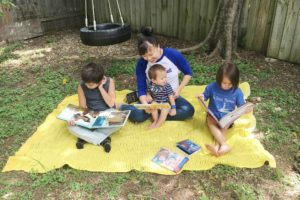Speech Therapy and Work-Life Balance
What’s the number one question I get from the readers of our speech-language pathology blog? How do you maintain a job doing speech therapy and work-life balance? I admit that there is an abundance of questions related to speech therapy strategies, working with English Language Learners and service delivery models; however, once I start talking with the SLPs and SLPs-to-be, this one question always comes up. Here’s the one thing I’ve learned as a 37-year-old, full-time speech-language-pathologist, mother of three—we are all striving to find a profession that feeds the soul and allows us the opportunity to feel like we are making a meaningful difference.
What is Work/Life Balance?
First, what exactly is work/life balance? After perusing the wide world web, I have surmised that two qualities determine success in our professional and personal lives—achievement and enjoyment. You want achievement and enjoyment in your job and your personal life. For me, I want to own my role as wife, mother and SLP well, and I want to find joy as I am doing these things.
The problem typically arises when our professional world overtakes the time we want to dedicate to our personal lives. As a former lead to approximately 45 SLPs in a school district, I recall talking to one of my team members. Let’s call her Suzy. It was time for our semester check-in, and Suzy reported that she stayed at school until 7pm each evening (school ended at 2:45pm) to complete all job-related tasks. She was feeling overwhelmed with her workload and did not know if she could continue as a school-based SLP for the following school year. Suzy felt like she was making a difference in the student’s lives (this is her ACHIEVMENT); however, she was losing her SLP-joy. And, to make matters worse, her time devoted to her job was taking away from her role as a mother to her two children. So, one can easily assume that Suzy did not have work/life balance.
So, when people ask me about speech therapy and work-life balance, I have some thoughts. And, I interviewed a few SLPs who continue to make important contributions to the field, run a household and, most importantly, are happy in the profession. Let’s get some perspective.
Honor Your Boundaries
Travis Chung, a former SLP lead in a large school district and father of a 10-month old baby, gives himself parameters on work and home separation. Travis does not bring his work home, and he leaves at the same time every day. And, tasks such as turning off phone notifications for his work email, help maintain uninterrupted home time.
Work/Life Balance Does Not Exist Within 24 Hours
Dr. Ellen Kester, founder of Bilinguistics and mother of three, acknowledges that balance does not happen equally within a 24-hour time span. “I don’t feel like I can have it all in one given day. It ebbs and flows.” So, for Ellen, knowing that a late evening involving writing a report will be complemented with an afternoon where she chooses to attend her children’s school parties. Acknowledging the realistic, day-to-day outcomes of acquiring achievement and enjoyment will set your expectations.
Perspective and Time Bring Clarity and Ease
Let’s check back in with Travis. He also acknowledged that, after a decade and half of working in the field, he is able to operate on auto-pilot more often when it comes to job-related duties. “It gets easier.” And, I whole-heartedly agree with him.
In the words of Travis, “Work hard. Enjoy the fun. Practice patience. Your bowl of pho will arrive before you know it.”
For me, I will say that earlier in my career, I had to put in the time to learn the processes, learn the systems, learn the tools, learn the evidence-based practices, learn the people. This meant staying at work longer on most days to understand what I needed to do. This meant taking the time to talk to those who knew more than I did. This meant asking for help and giving the time to those willing to help me. This meant working on the weekend to ensure that I was prepared for Monday morning. It was a humbling and memorable time.
And, I will also say that as I learned, I also got organized. For example, when I used the book, A Chair for My Mother, I made sure I kept all of the grade-level aligned materials systematized (including my go-to Storybook Therapy Intervention Template that I’ve used for almost a decade). That way, I could just pull out that folder for future sessions with new students and clients.
Be all of YOU in both arenas
Here’s the one lesson that proved to yield great outcomes. I love my family, and I love my job, and it’s challenging to keep the two arenas separate when it comes to matters of the heart. Ellen and I both share our work with our offspring, and we bring our family stories, interests and experiences into our therapy sessions. Take for instance, for me, I love music of the hip-hop persuasion. Coupled with some brain-based strategies, I use this form of music in my therapy session. Check out the story grammar rap below. And, when at home, I often find myself talking to my children about the important work I do. Just the other day, my 7-year-old observed a child with communication needs in a store. When we got back in the car, he said, “Mama, you can help him! Go tell his mom!” It’s amazing what happens when our work and personal lives align to support the communication needs of our students and clients.







Phuong,
Thanks so much for your wise words on the important topic of work-life balance! I agree that it gets easier over time, especially if we keep materials and ideas organized for future use. I would expand Ellen’s comment that we can’t have it all in one given day; it ebbs and flows. It ebbs and flows over the course of our careers too! I have more time to focus on work now than I did when my four children were growing up. Last, I just want to say I love it that you included a clip from your fabulous day with us in Fort Worth ISD!
Lori,
Thanks so much for your feedback. I also appreciate your perspective on the seasonal changes we have throughout the tenure of our career. With three children in tow, this perspective brings me comfort. And, it was a wonderful day in Fort Worth. See you at TSHA!
Amen Travis! I follow the same rules and find that it has helped me still feel excited about my job.
Mary! Travis surely speaks the truth! And, I’m glad you continue to find the enthusiasm in your important profession. I feel the same way :).